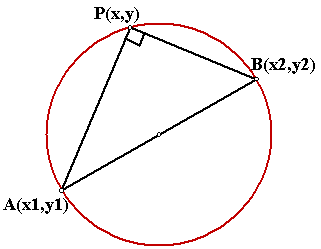Diameter Form of a circle |
|
|
The Diameter Form Formula Let The
gradients, Since ÐAPB is a right
angle (Ð in
semi-circle), We get the equation of the circle: |
|
The Pitfall
Equation (1)
is not a complete circle. It is a circle with four “holes” A, B, C, D. (Two
holes if the diameter is perpendicular or parallel to the x-axis). The reason is
that if x = x1 or x = x2, the denominator of the left
hand side of (1) is equal to zero, making the equation undefined. Points A and
C have the first coordinates x1. Points B and
D have the first coordinates x2. |
|
Vectors
For students who know vector operations can get
the Diameter Form easier: Since ÐAPB is a right
angle (Ð in
semi-circle), \ |
|
Exercise1. Since ÐAPB is a right angle, can
you use the Pythagoras Theorem to get the Diameter Form
of the circle? Can you
simplify to get (2) again? 2. Can you find the
mid-point of the diameter AB? This
is the center of the circle. Can
you find the radius of the circle? Use the Center-radius Form of the circle to
find the Diameter Form. (equation (2)) |
|




